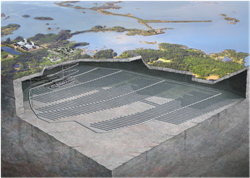
MITIGATION
- Image: 3D diagram of radwaste repository concept. SKB - Illustrator: LAJ Illustration. © NDA. Reproduced by permission.
The meeting observed that CCS exists only as a direct mitigation response to the threat of global warming, whereas GD is all about ensuring safety from hazardous materials. This distinction does not really hold much water: although CO
2 is a part of the natural carbon cycle and not hazardous in dilute quantities, human and environmental safety is paramount in both cases. The safety of GD is judged by estimates of radiation exposures to localised, hypothetical, individuals in the distant future, whereas the success of CCS is primarily judged by the ‘safety’ it delivers to the global environment.
Carrying out CCS ‘safely’ is thus simply a constraint on a technology with considerably greater objectives. The environmental consequence of failing to implement CCS are different in magnitude to that of, say, poorly executed GD – but both have their foundation in the provisionof safety. Nevertheless, CCS is also looking at the utility and feasibility of local safety targets for releases during the operational phase in terms of ‘admissible annual CO
2 release rates per unit area’. This stands in contrast to GD, where releases are judged in terms of exposure of people. CO
2 release targets are set more in terms of their impact on the health of ecosystems. Another aspect of this is the number of facilities that might exist worldwide over the next century. For GD this is likely mean tens, whereas for CCS to achieve its objective, it must be many hundreds.
Permanent containment below surface is the objective of both technologies; but geologists understand that 'permanent' has no real meaning, and is anyway unnecessary because of changing hazard potential through time. The way that this translates into achievable goals provides a clearer distinction between CCS and GD, in terms of containment timescales.